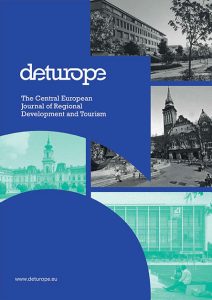DETUROPE – The Central European Journal of Regional Development and Tourism,
2024 (vol. 16), issue 3
The publication provides a selection of papers in connection with the 21st Annual Meeting of the Hungarian Regional Science Association (HRSA). This thematic issue gives a brief overview of the urban, regional and border studies focusing on this European macro-region, in the contact zone of Central Europe and the Balkans.
Editors of the thematic issue: ldikó Egyed and Szilárd Rácz
Original scientific papers
Ethnic diversity changes of Vojvodina between 1990 and 2020
Dávid Moró, Péter Reményi
Vojvodina, a region in the southern part of the Pannonian Plain, is home to a significant Hungarian ethnic minority living beyond the borders of Hungary. Located in northern Serbia, it has become one of Europe’s most ethnically diverse regions since the 17th and 18th centuries. This diversity is largely due to planned and spontaneous migrations aimed at compensating for the substantial population loss that occurred during the Ottoman conquest of the region and the subsequent wars of reconquest. Historical, political, and economic transformations have drastically altered the dynamics between ethnic groups multiple times. In the second half of the 20th century, homogenization at the provincial level became a predominant trend. Conversely, at the municipal level, various degrees of parallel homogenization and diversification can be observed, depending on local ethnic structures and regional demographic changes. Analyzing ethnic diversity plays a crucial role in quantitative ethnic studies; however, the societal effects of this diversity are still widely debated. Using the ethnic diversity index, we analyze census results from Yugoslavia and Serbia to identify major trends regarding changes in ethnic diversity at both the regional and municipal levels. We argue that large-scale homogenization occurred in the 1990s at the regional level, a trend that has continued thereafter, albeit at a reduced pace. Changes at the municipality level, however, varied significantly, influenced by both spatial and ethnic factors. We have organized the municipalities into four basic groups based on their ongoing diversification processes and current levels of ethnic diversity compared to the regional average.
Keywords: Vojvodina, ethnic diversity, homogenization, ethnic diversity index
The evolution of SME development in the EU’s cross-border cooperation: the example of direct funding in the Hungary-Croatia Interreg programme
Zoltán Pámer, Petra Buttinger, György Márton
Cross-border cooperation has become an integrated element of the European Union’s Cohesion Policy. In line with the strategic objectives, entrepreneurship and innovation have gained importance from period to period. Although cross-border programmes are generally understood as non-profit schemes, direct SME funding appeared already in the 2007-2013 period. On the basis of some Western European examples, a pilot programme was implemented in the Croatia-Hungary border area in the 2014-2020 period that directly supported businesses. The paper, after providing an overlook on SME development in EU cross-border cooperation, summarises the particularities of the analysed instrument. The paper defines two research questions: sectoral characteristics, specialisation patterns in some types of settlements; and the presence of innovation in the submitted and funded projects. The first question is answered through an analysis of the sectoral and settlement category breakdown of projects, while for the second a simple methodology is presented to measure to what extent innovation was in focus. For the analysis programme level data was used. The paper’s main finding is that, due to the logic of the scheme, innovation was easier to present in the case of more “materialised” sectors, such as wood processing, manufacturing and machine production, leading to higher success rates than in case of the service sector where cooperation between partners was less obvious. Even if the majority of the projects only promoted market entrance instead of innovation, rural areas have shown a higher success rate, demonstrating a relatively balanced spatial structure.
Keywords: cohesion policy, cross-border cooperation, SME development, innovation, Hungary, Croatia
Economic and demographic dynamics in Central European border regions between 2014-2020
Gábor Lados, Dávid Nagy, Réka Horeczki
In our study, we present the main characteristics of economic and population dynamics in border regions in Central Europe. In the analysed area, regime change, and later EU accession have activated and deepened horizontal cross-border interactions within and outside the region, often in order to access EU funds. A number of principles and development methods aim at reducing territorial disparities and thus the negative effects of borderlessness. Democratic local and regional structures, as well as local and regional cooperations with common interests along borders, further deepen the decentralisation process. The reduction of development disparities and the catching-up of underdeveloped regions often concern border regions. The aim of the study is to describe the inequalities (in economic and demographic situation) of Central Europe’s regions, highlighting the best-performing and the worst ranked regions in demographic dynamics.
Keywords: Central Europe, border, demography, territorial disparities
Report
International conference on the 40th anniversary of the Institute for Regional Studies
Zsuzsanna Zsibók, Réka Horeczki
On the occasion of the 40th anniversary of the Institute for Regional Studies, the HUN-REN CERS organised a three-day event series in May 2024 in the Granary visitor centre of the Bishopric of Pécs. On the first day, the 10th Village Conference was held, and the international “RKK40” anniversary conference in English on the second and third days.



